After the death of the Twelfth Tulku, the lamas of Zuru asked the terton to advise where the next Tulku would reincarnate. Jetrung Rinpoche said he saw signs that Konchog Gyurme had transferred his consciousness to Ngayab Ling pure land and would remain there for three years, as well as simultaneously travel to many other Buddha-fields. He would then reincarnate, his next father having been born in the Tiger year and his mother in the Bird year.
When the time had come for the thirteenth Tulku to be born, the wonderful lamas again asked Jetrung Rinpoche for his advice. Jetrung Rinpoche together with Lama Trinlay Konchab, a high Bodhisattva from Zuru Gompa, and Laksam Naljorpa, a powerful yogi, went into retreat to divine the birthplace of Zasep Tulku. Using their great psychic powers the three yogis, by direct vision and dreams, saw with perfect clarity exactly where he would be reborn. Monks from Zuru Gompa went to the place indicated.
Zasep Tulku Rinpoche, the thirteenth incarnation and our present teacher, was born in the year of the Earth-Ox-with-golden-nose-ring (6), 1st of July 1948. His father’s name was Karma Dugdak, and his mother’s name Paltso.
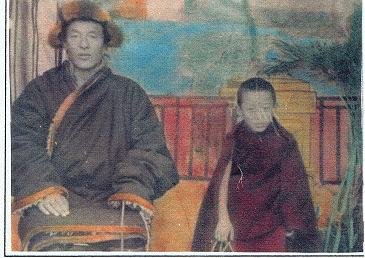
Zasep Tulku Rinpoche with his Grandfather
As Jetrung Rinpoche had predicted, the father had been born in the Tiger year and his mother in the Bird year. Prior to his birth, Paltso had auspicious dreams and during his birth she experienced no pain. The family had very good dreams, and the whole of Gerjel province had a fine year with no pestilence or disease and good seasonal weather. The high Kargyn, Sakya and Gelug lamas recognized Zasep Tulku when he was born and pointed out, referring to the miraculous signs that had appeared at his birth, that he was a very highly realized and powerful Rinpoche.
Installation at Zuru Gompa
Until the age of five, Zasep Tulku remained at home. He was then taken on horse in procession to Zuru Gompa. As he entered the gompa he passed between rows of musicians playing sacred instruments and was escorted into the temple under an ornamented victory umbrella. He was installed with great ceremony. Thousands of people came to Zuru Gompa to meet young Zasep Tulku, to receive blessings and to make offerings. Rinpoche received the robes, hats and bowl of the previous incarnation.
He stayed for two years in Zuru Gompa and learned the alphabet, the many daily prayers of Zuru and the Tunzhi prayer. He liked to read the One Thousand Songs of Milarepa (Mila Gurbung) and the sutra of Great Liberation (Tharpa Chenpodo).
When he was seven, Zasep Tulku visited his parents and the people of his village. His family invited his uncle, a renowned Kargyupa teacher who had meditated in seclusion for nineteen years, to his home to meet him. From this holy lama, the Venerable Sachyu Tulku, Zasep Tulku received Amitayus (Tib. Tsepame) long life and Tara (Tib. Drolma) initiations.
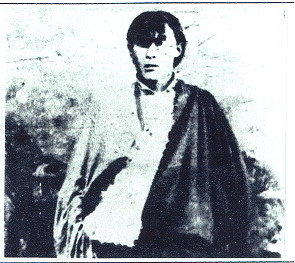
Zasep Tulku Rinpoche’s grandfather at a younger age
Rinpoche’s grandfather took him to Tashi Lhapug Gompa to study. At Tashi Lhapug, where there were 700 monks, is the largest monastery of the Geluk order in that area. Here Zasep Tulku took eight precepts and robes from the holy Gelug lama Chonjor Gyaltso. He received the name Jamyang Thubten Lodro. Lama Chonjor Gyaltso Mahasiddha was a disciple of the great Phabongkhapa Dechin Nying Po. He became oracle of Damchen Chogyal or Kalarupa the Dharma Protector of Gelukpa Lineage, an emanation of Yamantaka. He had completed the 108 Cemetery meditations and had meditated by 108 springs so as to help the cemetery beings and nagas. He gave many blessings to Zasep Tulku.
Zasep Tulku studied and meditated at Tashi Lhapug and received Yamantaka (Tib. Dorje Jigje Pawo Chikpa) initiation from the great Bodhisattva Lama Lodro Dragpa.
At the request of the many Kargyupa monks at Zuru, he returned to learn Kargyu practice from Lama Trinlay Konchob. From Geshe Tsegyam, a Kargyupa monk who had studied at Sera, he received teachings on Je Tzong Khapa’s Lam Rim.
To Lhasa and Sera
Zasep Tulku left Zuru Gompa in the spring of 1957, due to bad conditions existing in Kham province following the communist invasion of that year. He was accompanied on a journey to Lhasa by his uncle.
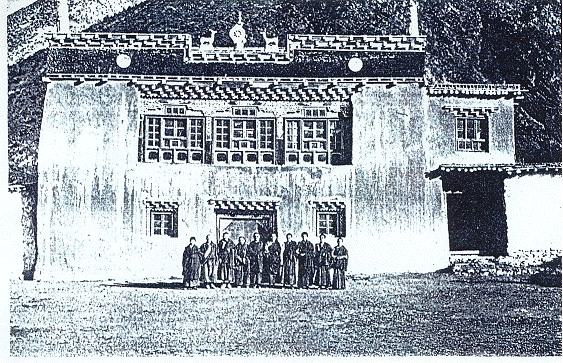
Sera Monastery
On the way to Lhasa, Zasep Tulku stayed for three months at Nalanda, A Sakyapa monastery, to receive detailed teachings. He felt great devotion for the Sakyapa teachings. From the abbot, Lama Zinwog Dorje Chang, he received an Amitayus initiation.
In Lhasa he met His Holiness Yongzin Trijang Rinpoche, who was the junior tutor of His Holiness the Dalai Lama. He was one of the greatest Lamas in this century. Yongzin Trijang Dorje Chang, a very holy yogi Bodhisattva who has total clairvoyance, immediately recognized Zasep Tulku as the incarnation of Konchog Gyurme. He suggested that Zasep Tulku go to Sera Monastic University to further his studies and learn Madhyamika philosophy.
On his arrival at Sera, Zasep Tulku entered Sera Je Tratzang where he was installed as a lama with great ceremony. From Geshe Jampa Chogdup he received teachings on Pramanavatika by Dharmakirti.
In 1958, Sera Ngapa Tratzang (the Tantric College) invited Yongzin Trijang Dorje Chang to the college to give initiations. From this holy lama, Zasep Tulku — then ten years old — received Guhyasamaja Akshobhya Vajra, Heruka Tilbu Lhanga, Thirteen Deities of Yamantaka, and Kunrig Yoga Tantra initiations.
At the end of 1958, Zasep Tulku went on a pilgrimage for six months. He visited Tashilhunpo Monastery, the Sakya monastery, and Tingri Langkor, the temple of Pha-Dampa Sangye (the lineage holder of Chod practice. He was the Guru of Machig LabKyi Dolma.) Tingri is the town on the Tibetan slope of Mount Everest where the great yogi Pha-Dampa Sangye taught.
Then Rinpoche and his party went to Mount Kailash. At this holy mountain Zasep Tulku made two months of Ngondro (preliminary practices) including prostrations, and a Migtzema retreat. He went to three of Milarepa’s caves: Zurtrul Pug (manifestation cave), Dra Pug (yak horn cave), and Choku Pug (Dharmakaya cave). He then returned to Sera.
Escape from Tibet
Three months later the communists invaded Lhasa. Zasep Tulku escaped from Sera walking by night across the monolithic mountain range between Lhasa and Penpo. He went to Nalanda Gompa for two days. In order to escape the communists he continued by horse across the great western grass plains of Tibet, carrying only a tent and a few possessions. His small party had to go many days without food. They turned south and traveled by day and night to cross the Nepalese border at Mustang, into freedom.
At Mustang border is the holy pilgrimage town of Muktinath. Zasep Tulku stayed there three months to do another set of Ngondro and a Guru Yoga retreat. Rinpoche’s mother passed away near Mustang due to illness and the Chinese taking away and jailing Rinpoche’s father.
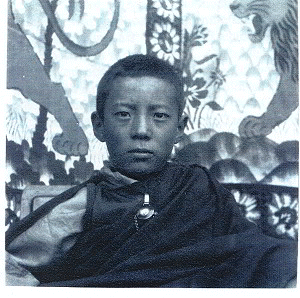
Zasep Tulku Rinpoche, age 11
Rinpoche then went to Kathmandu to see the three great stupas of Swayambhunath, Boudhanath and Namo Buddha. At Parping, the holy place of Vajra Yogini (Tib. Dorje Naljorma) and Padma Sambhava, he made more prostrations and mandala offerings.
In the small Nepalese village behind the Great Stupa of Boudhanath, Zasep Tulku did a five-month Vajrasattva (Tib. Dorje Sempa) and Guru Yoga retreat.
In 1961, he went to Dharamsala in north India. Here he rejoined his kind and holy teacher, the Venerable Trijang Dorje Chang and met Yongzin Ling Rinpoche again. In the same year he took Getsul (novice monk) ordination from Trijang Rinpoche.
The Ven. Geshe Thubten Wanggyel
Wanting to practice Dharma very strongly, he asked Trijang Rinpoche where to go to receive further teachings on Sutra and Tantra. Trijang Rinpoche told him to go to Dalhousie in the high Himalayas to live and study with Geshe Thubten Wanggyel, a highly realized being. When Trijang Rinpoche mentioned the name of this great teacher, Zasep Tulku felt very happy because of a strong karmic connection existing between them.
Zasep Tulku arrived at the home of Geshe Thubten Wanggyel on the morning that Geshe was completing his six-month Demchog (Sri Heruka) retreat with a fire puja. Although Zasep Tulku had not seen Geshe Wanggyel before, great faith and devotion rose in him at their meeting and he made request to stay with Geshe to meditate and receive teachings. Geshe happily accepted Zasep Tulku as his disciple. Geshe-la said, “I’m honored to accept you as my student because my root Guru Trijang Dorje Chang sent you to me. Trijang Dorje Chang knows that we will develop good teacher and student relationship.”
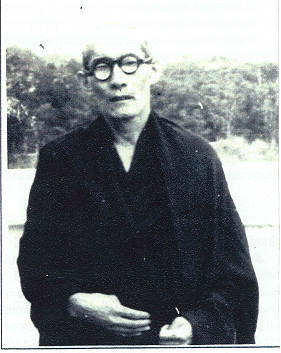
Geshe Thubten Wanggyel
Geshe Thubten Wanggyel lived in an austere and simple manner. He had few possessions, as he had totally abandoned the eight worldly dharmas. Zasep Tulku studied with him for ten years and during that time received teachings on the Pramanavatika, Prajnaparamita, Madhyamika, Abhidharma, Vinaya and Tzong Khapa’s Lam Rim. He also received many profound Tantric teachings.
Almost every winter for ten years, Zasep Tulku did four months’ retreat with his teacher in the mountains above Dalhousie. He and his guru lived in an old colonial English cottage called Bright View, from which they could see the whole Himalayan chain. Sometimes the snow against the cottage was eight feet deep and they couldn’t open the door in the morning. Zasep Tulku made Lam Rim, Bodhicitta and Shunyata retreats as well as Chenrezig, Tara, Vajra Yogini, Yamantaka and other daily retreats.
During the summer, Zasep Tulku received teachings on five different texts simultaneously. At night he meditated and recited sadhanas with Geshe Wanggyel. Having been taught a technique of quiescence and concentration meditation one day, Zasep Tulku would be questioned the following day about his meditation experience. If his answer was not satisfactory, Geshe asked him to practice more and more. Geshe was wrathful and he was a very strict teacher. Zasep Tulku was known as a good student and practitioner.
One evening Zasep Tulku was very tired and as he was meditating in front of Geshe, he started to drop off to sleep. Geshe picked up the small mud butter lamp, his daily offering to the Triple Gem, and threw it at Zasep Tulku. The lamp hit his head and broke into many pieces. Zasep Tulku wrapped his upper robe around his injured head to stop the blood. Seeing this, Geshe beat him and kicked him out of the house. Zasep Tulku had great devotion to his teacher and took his teacher’s harsh treatment as a blessing and initiation. Early the next morning he went to Geshe’s house and made prostrations before him. Geshe laughed for minutes, then patted Zasep Tulku on the head and gave him his old mala (rosary) as a blessing. That whole day Zasep Tulku was especially happy; his meditations were good and he realized that his teacher had helped him to quickly purify much bad karma. Geshe was a very loving and humble Bodhisattva. Zasep Tulku understood that these beatings were only for his own benefit, and although they caused physical pain, they never made him unhappy.
Geshe used to say, “After overcoming many physical difficulties and mental hindrances with enthusiasm and calm perseverance, your mind will naturally open, revealing its inner radiance, just as the Blue Lotus which remains closed by the pale light of the moon opens as the sun rises to reveal its true beauty and splendor.”
In 1966, Zasep Tulku received the transmission of the complete works of Tzong Khapa on Sutra and Tantra from Pangnang Rinpoche and the transmissions of four volumes of Gyaltsabje, a disciple of Tzong Khapa. In addition, he received the transmission of eight volumes of Kadruje and the transmission of Getongpa (Prajnaparamita in 8,000 verses.)
Endnotes
6. According to Zasep Rinpoche, the “Golden Nose Ring” indicates that someone born in that year will never be very rich, but neither will he/she be poor — a desirable state of affairs!
source: http://community.palouse.net/lotus/biop4.htm